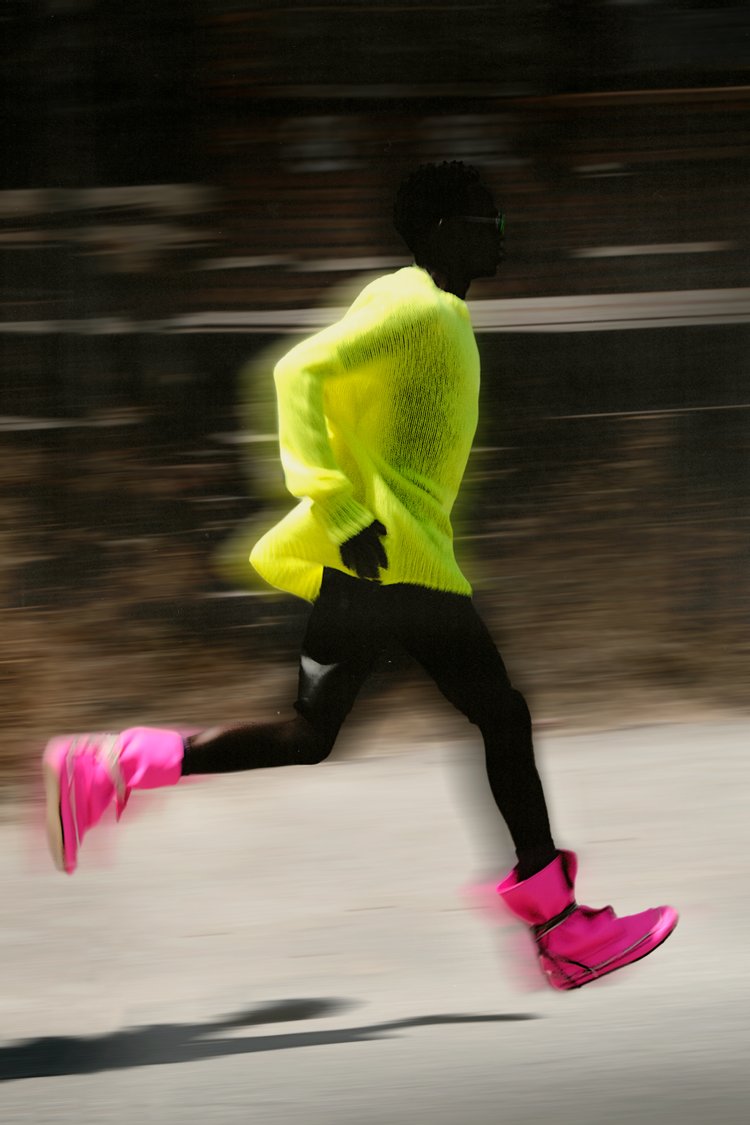24-Hour Party People: Inside Rave’s 21st-Century Redux
Inspired by ’90s Ibiza, Jonathan Anderson’s Loewe brings back clashing neons, punchy graphics and oversized sportswear.

1989’s “Second Summer of Love'' arrived with the explosion of UK acid house, an electronic music scene marked by psychedelic graphics, frenetic basslines and brazen hedonism. A direct response to the conservative Thatcher years, youth unemployment and heightened government distrust, rave, and its colorful, anything-goes style, defined one of Europe’s largest youth subcultures. As the weekend hit, young people from all walks of life grabbed their bucket hats, whistles and pacifiers, and descended on abandoned warehouses and open fields in rural towns—often to the alarm of countryside residents and local police forces alike. This was the UK’s answer to Chicago’s acid house rave culture and it defined an era.
At the same time rave was flourishing across the country, the Soviet Union and the Berlin Wall were collapsing, cultivating a spirit of openness that became the perfect breeding ground for electronic music to transcend language and borders. Fashion, too, was democratic because what mattered most was being comfortable and wearing clothes you can dance and sweat all night in. Labels like Versace and Moschino became popular in the scene, styled in a chaotic-fun mix of high and low. The criminalization of unlicensed raves added an anarchic political element as disenchanted youth danced out their frustrations. Raving was a statement of self-expression but, ultimately, the mood was led by feelings of peace, optimism and unity, aided by the fuzzy ecstasy-fueled feelings of love and happiness.
Fast forward to the late 2010s, and the COVID-19 pandemic welcomed a plethora of illegal parties, although these felt discordant with the uniting principles of early rave culture. In the late ’80s and into the ’90s, going to an unlicensed party wouldn’t result in you catching a potentially lethal virus. But as cases have fallen and nightlife has returned, partying has never felt like more of a refuge and a space for self-expression. Not having it for so long has made us appreciate it all the more.
For Spring/Summer 2022, designers are celebrating party culture’s triumphant return with highlighter-hued color palettes, cheerful slogans and lightweight tracksuits that wouldn’t have looked out of place at Manchester’s legendary Haçienda or at a Chicago warehouse. Jonathan Anderson, for instance, created a deeply personal exploration of rave for Loewe, translated via sporty silhouettes, clashing neon hues and oversized sweaters expressing the chaos and freedom of ’90s Ibiza. In an interview with Vogue, Anderson called the collection, “a message of electrifying hope and optimism.” Speaking of the inspiration, he recalled going to iconic Ibiza party Manumission with his brother and thinking, “Wow, in this moment these people could take over the world.”
The return of rave in fashion feels like a breath of fresh air following the apocalyptic collections of previous seasons. While the world might be a dark and frightening place, the message this season is that it’s alright to feel positive despite it all—even if only for a few hours on a Friday night. Dancing was a key inspiration for Martine Rose’s SS22 collection which captured older men—the OG raver generation perhaps—dancing in paint-splattered gabber tracksuits, with graphic prints taken from rave flyers.
At VTMNTS, models wore tiny sunglasses, tank tops, slogan tees and shoes painted with “Hard Core,” “Let Go” and “Fuck Off.” Dries Van Noten peppered his collection with prints of strobe-lit clubs, neon parkas and tinted shades in a lookbook shot around Antwerp. Meanwhile, Walter Van Beirendonck’s hedonistic ode to subcultures of the future imagined a trance techno group from the year 2057 with acid suiting, futuristic tracksuits and loud prints. But what is it about rave fashion that makes designers want to return to it today?
For one, rave symbolizes the apex of late-20th century youth culture. It was a global movement and one of the last pre-social media subcultures, embodying an experimental attitude that many designers pull from again and again. It’s both expressive and uniform, a space where you can flaunt daring new outfits or blend into the crowd as part of a united army against the world. Seen outside of a partying context, however, rave style is also appealing for its comfort and functionality. Whether kicking back at home or dancing into the morning, dressed-down adaptability is always appropriate. It’s also about rejecting the put-togetherness of the mainstream in favor of something more fluid and democratic.
Today, as clubs around the world face the threat of greedy developers, the spirit of rave is as important as ever. It’s where music and fashion meet with all the optimism of an acid house smiley face. Reflective tracksuits, neon bucket hats and oversized sweaters are back, a uniform for dancing all night long and fighting for our right to party. SS22 was just the beginning